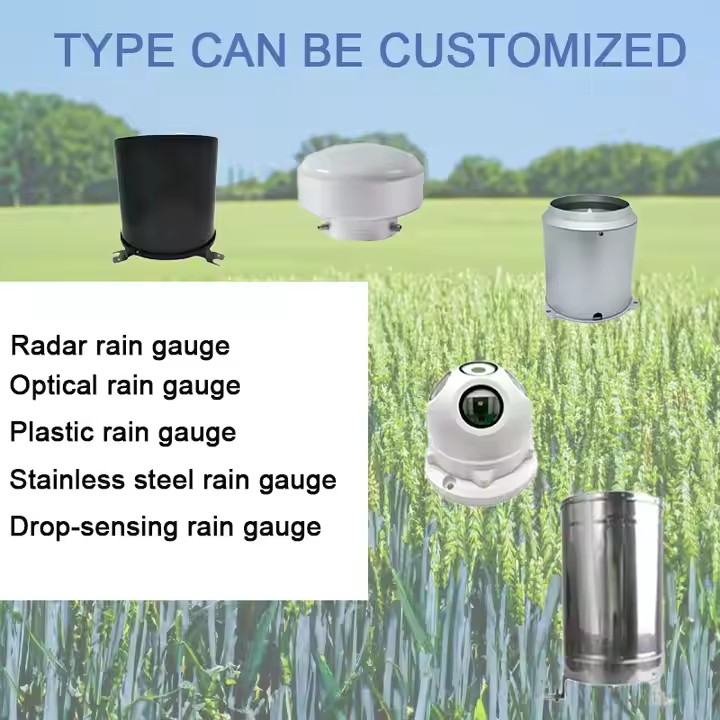Characteristics of Plum Rain Season and Rainfall Monitoring Needs
The plum rain (Meiyu) is a unique precipitation phenomenon formed during the northward advance of the East Asian summer monsoon, primarily affecting China’s Yangtze River basin, Japan’s Honshu Island, and South Korea. According to China’s national standard “Meiyu Monitoring Indicators” (GB/T 33671-2017), China’s plum rain regions can be divided into three zones: Jiangnan (I), Middle-Lower Yangtze (II), and Jianghuai (III), each with distinct onset dates—Jiangnan area typically enters Meiyu season first on June 9 on average, followed by Middle-Lower Yangtze on June 14, and Jianghuai on June 23. This spatiotemporal variability creates demand for extensive, continuous rainfall monitoring, providing broad application opportunities for rain gauges.
The 2025 plum rain season showed early onset trends—Jiangnan and Middle-Lower Yangtze regions entered Meiyu on June 7 (2-7 days earlier than usual), while Jianghuai region started on June 19 (4 days early). These early arrivals heightened flood prevention urgency. Plum rain precipitation features prolonged duration, high intensity, and wide coverage—for example, 2024′s Middle-Lower Yangtze rainfall exceeded historical averages by over 50%, with some areas experiencing “violent Meiyu” causing severe flooding. In this context, accurate rainfall monitoring becomes the cornerstone of flood control decision-making.
Traditional manual rainfall observations have significant limitations: low measurement frequency (typically 1-2 times daily), slow data transmission, and inability to capture short-term heavy rainfall. Modern automatic rain gauges using tipping-bucket or weighing principles enable minute-by-minute or even second-by-second monitoring, with wireless real-time data transmission greatly improving timeliness and accuracy. For instance, the tipping-bucket rain gauge system at Yongkang’s Sanduxi Reservoir in Zhejiang directly uploads data to provincial hydrological platforms, achieving “convenient and efficient” rainfall monitoring.
Key technical challenges include: maintaining accuracy during extreme rainfall (e.g., 660mm in 3 days at Hubei’s Taiping Town in 2025—1/3 of annual precipitation); equipment reliability in humid environments; and representative station placement in complex terrain. Modern rain gauges address these with stainless-steel anti-corrosion materials, dual tipping-bucket redundancy, and solar power. IoT-enabled dense networks like Zhejiang’s “Digital Levee” system update rainfall data every 5 minutes from 11 stations.
Notably, climate change is intensifying Meiyu extremes—2020′s Meiyu rainfall was 120% above average (highest since 1961), demanding rain gauges with broader measurement ranges, impact resistance, and reliable transmission. Meiyu data also supports climate research, informing long-term adaptation strategies.
Innovative Applications in China
China has developed comprehensive rainfall monitoring systems from traditional manual observations to smart IoT solutions, with rain gauges evolving into critical nodes of intelligent hydrological networks.
Digital Flood Control Networks
Xiuzhou District’s “Digital Levee” system exemplifies modern applications. Integrating rain gauges with other hydrological sensors, it uploads data every 5 minutes to a management platform. “Previously, we manually measured rainfall using graduated cylinders—inefficient and hazardous at night. Now, mobile apps provide real-time basin-wide data,” said Jiang Jianming, Deputy Director of Wangdian Town’s Agricultural Office. This allows staff to focus on proactive measures like dike inspections, improving flood response efficiency by over 50%.
At Tongxiang City, the “Smart Waterlogging Control” system combines data from 34 telemetry stations with AI-powered 72-hour water level forecasts. During 2024′s Meiyu season, it issued 23 rainfall reports, 5 flood warnings, and 2 peak flow alerts, demonstrating hydrology’s pivotal role as the “eyes and ears” of flood control. Minute-level rain gauge data complements radar/satellite observations, forming a multidimensional monitoring framework.
Reservoir and Agricultural Applications
In water resource management, Yongkang’s Sanduxi Reservoir uses automated gauges at 8 canal branches alongside manual measurements to optimize irrigation. “Combining methods ensures rational water allocation while improving monitoring automation,” explained manager Lou Qinghua. Rainfall data directly informs irrigation scheduling and water distribution.
During 2025′s Meiyu onset, Hubei’s Water Sciences Institute employed a real-time flood forecasting system integrating 24/72-hour weather predictions with reservoir data. Triggering 26 storm simulations and supporting 5 emergency meetings, the system’s reliability hinges on precise rain gauge measurements.
Technological Advancements
Modern rain gauges incorporate several key innovations:
- Hybrid Measurement: Combining tipping-bucket and weighing principles to maintain accuracy across intensities (0.1-300mm/h), addressing Meiyu’s variable rainfall.
- Self-Cleaning Designs: Ultrasonic sensors and hydrophobic coatings prevent debris accumulation—critical during heavy Meiyu downpours. Japan’s Oki Electric reports 90% maintenance reduction with such systems.
- Edge Computing: On-device data processing filters noise and identifies extreme events locally, ensuring reliability even with network disruptions.
- Multi-Parameter Integration: South Korea’s composite stations measure rainfall alongside humidity/temperature, improving Meiyu-related landslide predictions.
Challenges and Future Directions
Despite progress, limitations persist:
- Extreme Conditions: 2024′s “violent Meiyu” in Anhui overloaded some gauges’ 300mm/h capacity
- Data Integration: Disparate systems hinder cross-regional flood forecasting
- Rural Coverage: Remote mountainous areas lack sufficient monitoring points
Emerging solutions include:
- Drone-Deployed Mobile Gauges: China’s MWR tested UAV-carried gauges for rapid deployment during 2025 floods
- Blockchain Verification: Pilot projects in Zhejiang ensure data immutability for critical decisions
- AI-Powered Forecasting: Shanghai’s new model reduces false alarms by 40% through machine learning
With climate change intensifying Meiyu variability, next-generation gauges will require:
- Enhanced durability (IP68 waterproofing, -30°C~70°C operation)
- Broader measurement ranges (0~500mm/h)
- Tighter integration with IoT/5G networks
As Director Jiang notes: “What began as simple rainfall measurement has become the foundation for intelligent water governance.” From flood control to climate research, rain gauges remain indispensable tools for resilience in plum rain regions.
Please Contact Honde Technology Co., LTD.
Email: info@hondetech.com
Company website: www.hondetechco.com
Tel: +86-15210548582
Post time: Jun-25-2025


